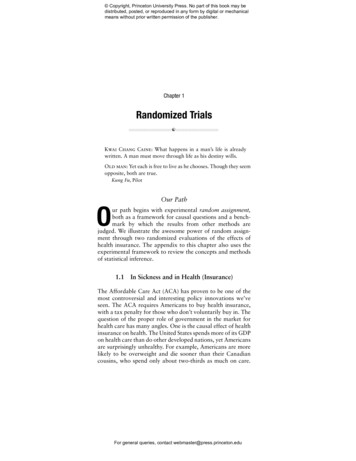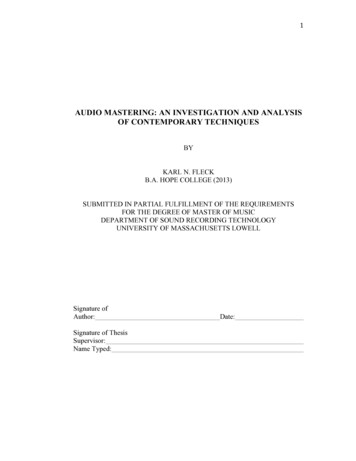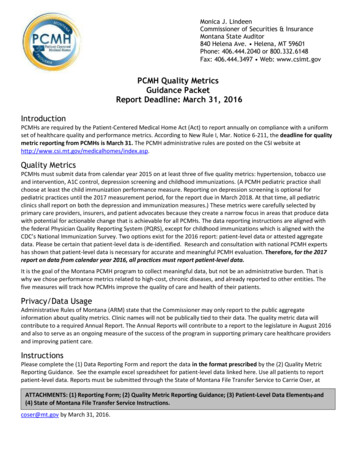
Transcription
Copyright, Princeton University Press. No part of this book may bedistributed, posted, or reproduced in any form by digital or mechanicalmeans without prior written permission of the publisher.Chapter 1Randomized TrialsKwai Chang Caine: What happens in a man’s life is alreadywritten. A man must move through life as his destiny wills.Old man: Yet each is free to live as he chooses. Though they seemopposite, both are true.Kung Fu, PilotOur PathOur path begins with experimental random assignment,both as a framework for causal questions and a benchmark by which the results from other methods arejudged. We illustrate the awesome power of random assignment through two randomized evaluations of the effects ofhealth insurance. The appendix to this chapter also uses theexperimental framework to review the concepts and methodsof statistical inference.1.1In Sickness and in Health (Insurance)The Affordable Care Act (ACA) has proven to be one of themost controversial and interesting policy innovations we’veseen. The ACA requires Americans to buy health insurance,with a tax penalty for those who don’t voluntarily buy in. Thequestion of the proper role of government in the market forhealth care has many angles. One is the causal effect of healthinsurance on health. The United States spends more of its GDPon health care than do other developed nations, yet Americansare surprisingly unhealthy. For example, Americans are morelikely to be overweight and die sooner than their Canadiancousins, who spend only about two-thirds as much on care.For general queries, contact webmaster@press.princeton.edu
Copyright, Princeton University Press. No part of this book may bedistributed, posted, or reproduced in any form by digital or mechanicalmeans without prior written permission of the publisher.2Chapter 1America is also unusual among developed countries in havingno universal health insurance scheme. Perhaps there’s a causalconnection here.Elderly Americans are covered by a federal program calledMedicare, while some poor Americans (including most singlemothers, their children, and many other poor children) arecovered by Medicaid. Many of the working, prime-age poor,however, have long been uninsured. In fact, many uninsuredAmericans have chosen not to participate in an employerprovided insurance plan.1 These workers, perhaps correctly,count on hospital emergency departments, which cannot turnthem away, to address their health-care needs. But the emergency department might not be the best place to treat, say,the flu, or to manage chronic conditions like diabetes andhypertension that are so pervasive among poor Americans. Theemergency department is not required to provide long-termcare. It therefore stands to reason that government-mandatedhealth insurance might yield a health dividend. The push forsubsidized universal health insurance stems in part from thebelief that it does.The ceteris paribus question in this context contrasts thehealth of someone with insurance coverage to the health ofthe same person were they without insurance (other than anemergency department backstop). This contrast highlights afundamental empirical conundrum: people are either insuredor not. We don’t get to see them both ways, at least not at thesame time in exactly the same circumstances.In his celebrated poem, “The Road Not Taken,” RobertFrost used the metaphor of a crossroads to describe the causaleffects of personal choice:Two roads diverged in a yellow wood,And sorry I could not travel bothAnd be one traveler, long I stoodAnd looked down one as far as I couldTo where it bent in the undergrowth;1 For more on this surprising fact, see Jonathan Gruber, “Covering theUninsured in the United States,” Journal of Economic Literature, vol. 46,no. 3, September 2008, pages 571–606.For general queries, contact webmaster@press.princeton.edu
Copyright, Princeton University Press. No part of this book may bedistributed, posted, or reproduced in any form by digital or mechanicalmeans without prior written permission of the publisher.Randomized Trials3Frost’s traveler concludes:Two roads diverged in a wood, and I—I took the one less traveled by,And that has made all the difference.The traveler claims his choice has mattered, but, being onlyone person, he can’t be sure. A later trip or a report by othertravelers won’t nail it down for him, either. Our narrator mightbe older and wiser the second time around, while other travelers might have different experiences on the same road. So itis with any choice, including those related to health insurance:would uninsured men with heart disease be disease-free if theyhad insurance? In the novel Light Years, James Salter’s irresolute narrator observes: “Acts demolish their alternatives, thatis the paradox.” We can’t know what lies at the end of the roadnot taken.We can’t know, but evidence can be brought to bear on thequestion. This chapter takes you through some of the evidencerelated to paths involving health insurance. The starting pointis the National Health Interview Survey (NHIS), an annualsurvey of the U.S. population with detailed information onhealth and health insurance. Among many other things, theNHIS asks: “Would you say your health in general is excellent,very good, good, fair, or poor?” We used this question to codean index that assigns 5 to excellent health and 1 to poor healthin a sample of married 2009 NHIS respondents who may ormay not be insured.2 This index is our outcome: a measurewe’re interested in studying. The causal relation of interesthere is determined by a variable that indicates coverage byprivate health insurance. We call this variable the treatment,borrowing from the literature on medical trials, although thetreatments we’re interested in need not be medical treatmentslike drugs or surgery. In this context, those with insurance canbe thought of as the treatment group; those without insurancemake up the comparison or control group. A good controlgroup reveals the fate of the treated in a counterfactual worldwhere they are not treated.2 Our sample is aged 26–59 and therefore does not yet qualify for Medicare.For general queries, contact webmaster@press.princeton.edu
Copyright, Princeton University Press. No part of this book may bedistributed, posted, or reproduced in any form by digital or mechanicalmeans without prior written permission of the publisher.4Chapter 1The first row of Table 1.1 compares the average health indexof insured and uninsured Americans, with statistics tabulatedseparately for husbands and wives.3 Those with health insurance are indeed healthier than those without, a gap of about.3 in the index for men and .4 in the index for women. Theseare large differences when measured against the standard deviation of the health index, which is about 1. (Standard deviations, reported in square brackets in Table 1.1, measurevariability in data. The chapter appendix reviews the relevantformula.) These large gaps might be the health dividend we’relooking for.Fruitless and Fruitful ComparisonsSimple comparisons, such as those at the top of Table 1.1, areoften cited as evidence of causal effects. More often than not,however, such comparisons are misleading. Once again theproblem is other things equal, or lack thereof. Comparisonsof people with and without health insurance are not apples toapples; such contrasts are apples to oranges, or worse.Among other differences, those with health insurance arebetter educated, have higher income, and are more likely tobe working than the uninsured. This can be seen in panel Bof Table 1.1, which reports the average characteristics ofNHIS respondents who do and don’t have health insurance.Many of the differences in the table are large (for example,a nearly 3-year schooling gap); most are statistically preciseenough to rule out the hypothesis that these discrepancies aremerely chance findings (see the chapter appendix for a refresher on statistical significance). It won’t surprise you tolearn that most variables tabulated here are highly correlatedwith health as well as with health insurance status. Moreeducated people, for example, tend to be healthier as well asbeing overrepresented in the insured group. This may be because more-educated people exercise more, smoke less, andare more likely to wear seat belts. It stands to reason thatthe difference in health between insured and uninsured NHIS3 An Empirical Notes section after the last chapter gives detailed notes forthis table and most of the other tables and figures in the book.For general queries, contact webmaster@press.princeton.edu
Copyright, Princeton University Press. No part of this book may bedistributed, posted, or reproduced in any form by digital or mechanicalmeans without prior written permission of the publisher.Randomized Trials5Table 1.1Health and demographic characteristics of insured and uninsuredcouples in the NHISHusbandsSome HI(1)No HI(2)WivesDifference Some HI(3)(4)No HI(5)Difference(6)4.02[.92]3.62[1.01].39(.04)A. HealthHealth index4.01[.93]3.70[1.01].31(.03)B. Characteristics.16.17 .01(.01).15.17 ly size3.503.98 .47(.05)3.493.93 teFamily income 106,467 45,656Sample size8,1141,28160,810(1,355)106,212 46,3858,26459,828(1,406)1,131Notes: This table reports average characteristics for insured and uninsured marriedcouples in the 2009 National Health Interview Survey (NHIS). Columns (1), (2), (4), and(5) show average characteristics of the group of individuals specified by the column heading.Columns (3) and (6) report the difference between the average characteristic for individualswith and without health insurance (HI). Standard deviations are in brackets; standard errorsare reported in parentheses.For general queries, contact webmaster@press.princeton.edu
Copyright, Princeton University Press. No part of this book may bedistributed, posted, or reproduced in any form by digital or mechanicalmeans without prior written permission of the publisher.6Chapter 1respondents at least partly reflects the extra schooling of theinsured.Our effort to understand the causal connection between insurance and health is aided by fleshing out Frost’s two-roadsmetaphor. We use the letter Y as shorthand for health, theoutcome variable of interest. To make it clear when we’retalking about specific people, we use subscripts as a standin for names: Yi is the health of individual i. The outcome Yi isrecorded in our data. But, facing the choice of whether to payfor health insurance, person i has two potential outcomes, onlyone of which is observed. To distinguish one potential outcomefrom another, we add a second subscript: The road taken without health insurance leads to Y0i (read this as “y-zero-i”) forperson i, while the road with health insurance leads to Y1i (readthis as “y-one–i”) for person i. Potential outcomes lie at theend of each road one might take. The causal effect of insuranceon health is the difference between them, written Y1i Y0i .4To nail this down further, consider the story of visitingMassachusetts Institute of Technology (MIT) student KhuzdarKhalat, recently arrived from Kazakhstan. Kazakhstan has anational health insurance system that covers all its citizensautomatically (though you wouldn’t go there just for the healthinsurance). Arriving in Cambridge, Massachusetts, Khuzdar issurprised to learn that MIT students must decide whether toopt in to the university’s health insurance plan, for which MITlevies a hefty fee. Upon reflection, Khuzdar judges the MITinsurance worth paying for, since he fears upper respiratoryinfections in chilly New England. Let’s say that Y0i 3 andY1i 4 for i Khuzdar. For him, the causal effect of insuranceis one step up on the NHIS scale:Y1, Khuzdar Y0, Khuzdar 1.Table 1.2 summarizes this information.4 Robert Frost’s insights notwithstanding, econometrics isn’t poetry. Amodicum of mathematical notation allows us to describe and discusssubtle relationships precisely. We also use italics to introduce repeatedly usedterms, such as potential outcomes, that have special meaning for masters of’metrics.For general queries, contact webmaster@press.princeton.edu
Copyright, Princeton University Press. No part of this book may bedistributed, posted, or reproduced in any form by digital or mechanicalmeans without prior written permission of the publisher.Randomized Trials7Table 1.2Outcomes and treatments for Khuzdar and MariaKhuzdarKhalatMariaMoreñoPotential outcome without insurance: Y0i35Potential outcome with insurance: Y1i45Treatment (insurance status chosen): Di10Actual health outcome: Yi45Treatment effect: Y1i Y0i10It’s worth emphasizing that Table 1.2 is an imaginary table:some of the information it describes must remain hidden.Khuzdar will either buy insurance, revealing his value of Y1i ,or he won’t, in which case his Y0i is revealed. Khuzdar haswalked many a long and dusty road in Kazakhstan, but evenhe cannot be sure what lies at the end of those not taken.Maria Moreño is also coming to MIT this year; she hailsfrom Chile’s Andean highlands. Little concerned by Bostonwinters, hearty Maria is not the type to fall sick easily. Shetherefore passes up the MIT insurance, planning to use hermoney for travel instead. Because Maria has Y0, Maria Y1, Maria 5, the causal effect of insurance on her health isY1, Maria Y0, Maria 0.Maria’s numbers likewise appear in Table 1.2.Since Khuzdar and Maria make different insurance choices,they offer an interesting comparison. Khuzdar’s health isYKhuzdar Y1, Khuzdar 4, while Maria’s is YMaria Y0, Maria 5. The difference between them isYKhuzdar YMaria 1.Taken at face value, this quantity—which we observe—suggests Khuzdar’s decision to buy insurance is counterproductive. His MIT insurance coverage notwithstanding, insured Khuzdar’s health is worse than uninsured Maria’s.For general queries, contact webmaster@press.princeton.edu
Copyright, Princeton University Press. No part of this book may bedistributed, posted, or reproduced in any form by digital or mechanicalmeans without prior written permission of the publisher.8Chapter 1In fact, the comparison between frail Khuzdar and heartyMaria tells us little about the causal effects of their choices.This can be seen by linking observed and potential outcomesas follows:YKhuzdar YMaria Y1, Khuzdar Y0, Maria Y1, Khuzdar Y0, Khuzdar {Y0, Khuzdar Y0, Maria} . 21The second line in this equation is derived by adding andsubtracting Y0, Khuzdar, thereby generating two hidden comparisons that determine the one we see. The first comparison, Y1, Khuzdar Y0, Khuzdar, is the causal effect of healthinsurance on Khuzdar, which is equal to 1. The second,Y0, Khuzdar Y0, Maria, is the difference between the two students’ health status were both to decide against insurance.This term, equal to 2, reflects Khuzdar’s relative frailty. Inthe context of our effort to uncover causal effects, the lack ofcomparability captured by the second term is called selectionbias.You might think that selection bias has something to dowith our focus on particular individuals instead of on groups,where, perhaps, extraneous differences can be expected to“average out.” But the difficult problem of selection bias carries over to comparisons of groups, though, instead of individual causal effects, our attention shifts to average causaleffects. In a group of n people, average causal effects are written Avg n[Y1i Y0i ], where averaging is done in the usual way(that is, we sum individual outcomes and divide by n): [Y1i Y0i ]Avg n[Y1i Y0i ] 1nni 1n1 1 Y1i Y0i . nn i 1i 1n(1.1) The symbol ni 1 indicates a sum over everyone from i 1 ton, where n is the size of the group over which we are averaging.Note that both summations in equation (1.1) are taken overeverybody in the group of interest. The average causal effectFor general queries, contact webmaster@press.princeton.edu
Copyright, Princeton University Press. No part of this book may bedistributed, posted, or reproduced in any form by digital or mechanicalmeans without prior written permission of the publisher.Randomized Trials9of health insurance compares average health in hypotheticalscenarios where everybody in the group does and does nothave health insurance. As a computational matter, this is theaverage of individual causal effects like Y1, Khuzdar Y0, Khuzdarand Y1, Maria Y0, Maria for each student in our data.An investigation of the average causal effect of insurancenaturally begins by comparing the average health of groups ofinsured and uninsured people, as in Table 1.1. This comparisonis facilitated by the construction of a dummy variable, Di ,which takes on the values 0 and 1 to indicate insurance status: 1 if i is insuredDi 0 otherwise.We can now write Avg n[Yi Di 1] for the average among theinsured and Avg n[Yi Di 0] for the average among the uninsured. These quantities are averages conditional on insurance status.5The average Yi for the insured is necessarily an average ofoutcome Y1i , but contains no information about Y0i . Likewise,the average Yi among the uninsured is an average of outcomeY0i , but this average is devoid of information about the corresponding Y1i . In other words, the road taken by those withinsurance ends with Y1i , while the road taken by those withoutinsurance leads to Y0i . This in turn leads to a simple but important conclusion about the difference in average health byinsurance status:Difference in group means Avg n[Yi Di 1] Avg n[Yi Di 0] Avg n[Y1i Di 1] Avg n[Y0i Di 0],(1.2)5 Order the n observations on Y so that the n observations from the groupi0indicated by Di 0 precede the n1 observations from the Di 1 group. Theconditional averageAvg n [Yi Di 0] n01 Yin0 i 1is the sample average for the n0 observations in the Di 0 group. The termAvg n [Yi Di 1] is calculated analogously from the remaining n1 observations.For general queries, contact webmaster@press.princeton.edu
Copyright, Princeton University Press. No part of this book may bedistributed, posted, or reproduced in any form by digital or mechanicalmeans without prior written permission of the publisher.10Chapter 1an expression highlighting the fact that the comparisons inTable 1.1 tell us something about potential outcomes, thoughnot necessarily what we want to know. We’re afterAvg n[Y1i Y0i ], an average causal effect involving everyone’sY1i and everyone’s Y0i , but we see average Y1i only for theinsured and average Y0i only for the uninsured.To sharpen our understanding of equation (1.2), it helps toimagine that health insurance makes everyone healthier by aconstant amount, κ. As is the custom among our people, weuse Greek letters to label such parameters, so as to distinguishthem from variables or data; this one is the letter “kappa.”The constant-effects assumption allows us to write:Y1i Y0i κ ,(1.3)or, equivalently, Y1i Y0i κ. In other words, κ is both theindividual and average causal effect of insurance on health.The question at hand is how comparisons such as those at thetop of Table 1.1 relate to κ.Using the constant-effects model (equation (1.3)) to substitute for Avg n[Y1i Di 1] in equation (1.2), we have:Avg n[Y1i Di 1] Avg n[Y0i Di 0] {κ Avg n[Y0i Di 1]} Avg n[Y0i Di 0] κ Avg n[Y0i Di 1] Avg n[Y0i Di 0] . (1.4)This equation reveals that health comparisons between thosewith and without insurance equal the causal effect of interest(κ) plus the difference in average Y0i between the insured andthe uninsured. As in the parable of Khuzdar and Maria, thissecond term describes selection bias. Specifically, the differencein average health by insurance status can be written:Difference in group means Average causal effect Selection bias,where selection bias is defined as the difference in average Y0ibetween the groups being compared.For general queries, contact webmaster@press.princeton.edu
Copyright, Princeton University Press. No part of this book may bedistributed, posted, or reproduced in any form by digital or mechanicalmeans without prior written permission of the publisher.Randomized Trials11How do we know that the difference in means by insurance status is contaminated by selection bias? We knowbecause Y0i is shorthand for everything about person i related to health, other than insurance status. The lower part ofTable 1.1 documents important noninsurance differences between the insured and uninsured, showing that ceteris isn’tparibus here in many ways. The insured in the NHIS arehealthier for all sorts of reasons, including, perhaps, thecausal effects of insurance. But the insured are also healthier because they are more educated, among other things. Tosee why this matters, imagine a world in which the causaleffect of insurance is zero (that is, κ 0). Even in such aworld, we should expect insured NHIS respondents to behealthier, simply because they are more educated, richer, andso on.We wrap up this discussion by pointing out the subtlerole played by information like that reported in panel B ofTable 1.1. This panel shows that the groups being compareddiffer in ways that we can observe. As we’ll see in the next chapter, if the only source of selection bias is a set of differencesin characteristics that we can observe and measure, selectionbias is (relatively) easy to fix. Suppose, for example, that theonly source of selection bias in the insurance comparison iseducation. This bias is eliminated by focusing on samples ofpeople with the same schooling, say, college graduates. Education is the same for insured and uninsured people in such asample, because it’s the same for everyone in the sample.The subtlety in Table 1.1 arises because when observeddifferences proliferate, so should our suspicions about unobserved differences. The fact that people with and withouthealth insurance differ in many visible ways suggests that evenwere we to hold observed characteristics fixed, the uninsuredwould likely differ from the insured in ways we don’t see (afterall, the list of variables we can see is partly fortuitous). In otherwords, even in a sample consisting of insured and uninsuredpeople with the same education, income, and employment status, the insured might have higher values of Y0i . The principalchallenge facing masters of ’metrics is elimination of the selection bias that arises from such unobserved differences.For general queries, contact webmaster@press.princeton.edu
Copyright, Princeton University Press. No part of this book may bedistributed, posted, or reproduced in any form by digital or mechanicalmeans without prior written permission of the publisher.12Chapter 1Breaking the Deadlock: Just RANDomizeMy doctor gave me 6 months to live . . . but when I couldn’t paythe bill, he gave me 6 months more.Walter MatthauExperimental random assignment eliminates selection bias.The logistics of a randomized experiment, sometimes calleda randomized trial, can be complex, but the logic is simple. Tostudy the effects of health insurance in a randomized trial, we’dstart with a sample of people who are currently uninsured.We’d then provide health insurance to a randomly chosensubset of this sample, and let the rest go to the emergencydepartment if the need arises. Later, the health of the insuredand uninsured groups can be compared. Random assignmentmakes this comparison ceteris paribus: groups insured anduninsured by random assignment differ only in their insurancestatus and any consequences that follow from it.For general queries, contact webmaster@press.princeton.edu
Copyright, Princeton University Press. No part of this book may bedistributed, posted, or reproduced in any form by digital or mechanicalmeans without prior written permission of the publisher.Randomized Trials13Suppose the MIT Health Service elects to forgo payment andtosses a coin to determine the insurance status of new studentsAshish and Zandile (just this once, as a favor to their distinguished Economics Department). Zandile is insured if the tosscomes up heads; otherwise, Ashish gets the coverage. A goodstart, but not good enough, since random assignment of twoexperimental subjects does not produce insured and uninsuredapples. For one thing, Ashish is male and Zandile female.Women, as a rule, are healthier than men. If Zandile windsup healthier, it might be due to her good luck in having beenborn a woman and unrelated to her lucky draw in the insurancelottery. The problem here is that two is not enough to tangowhen it comes to random assignment. We must randomly assign treatment in a sample that’s large enough to ensure thatdifferences in individual characteristics like sex wash out.Two randomly chosen groups, when large enough, are indeed comparable. This fact is due to a powerful statisticalproperty known as the Law of Large Numbers (LLN). TheLLN characterizes the behavior of sample averages in relationto sample size. Specifically, the LLN says that a sample averagecan be brought as close as we like to the average in the population from which it is drawn (say, the population of Americancollege students) simply by enlarging the sample.To see the LLN in action, play dice.6 Specifically, roll a fairdie once and save the result. Then roll again and average thesetwo results. Keep on rolling and averaging. The numbers 1 to 6are equally likely (that’s why the die is said to be “fair”), so wecan expect to see each value an equal number of times if weplay long enough. Since there are six possibilities here, and allare equally likely, the expected outcome is an equally weightedaverage of each possibility, with weights equal to 1/6:1 16 2 16 3 16 4 16 5 16 6 161 2 3 4 5 6 3.5.66 Six-sided cubes with one to six dots engraved on each side. There’s an appfor ’em on your smartphone.For general queries, contact webmaster@press.princeton.edu
Copyright, Princeton University Press. No part of this book may bedistributed, posted, or reproduced in any form by digital or mechanicalmeans without prior written permission of the publisher.14Chapter 1This average value of 3.5 is called a mathematical expectation;in this case, it’s the average value we’d get in infinitely manyrolls of a fair die. The expectation concept is important to ourwork, so we define it formally here.The mathematical expectation of a variable, Yi , written E[Yi ], is the population averageof this variable. If Yi is a variable generated by a randomprocess, such as throwing a die, E[Yi ] is the average in infinitely many repetitions of this process. If Yi is a variablethat comes from a sample survey, E[Yi ] is the average obtained if everyone in the population from which the sampleis drawn were to be enumerated.MATHEMATICAL EXPECTATIONRolling a die only a few times, the average toss may be farfrom the corresponding mathematical expectation. Roll twotimes, for example, and you might get boxcars or snake eyes(two sixes or two ones). These average to values well awayfrom the expected value of 3.5. But as the number of tossesgoes up, the average across tosses reliably tends to 3.5. Thisis the LLN in action (and it’s how casinos make a profit: inmost gambling games, you can’t beat the house in the longrun, because the expected payout for players is negative). Moreremarkably, it needn’t take too many rolls or too large a samplefor a sample average to approach the expected value. Thechapter appendix addresses the question of how the numberof rolls or the size of a sample survey determines statisticalaccuracy.In randomized trials, experimental samples are created bysampling from a population we’d like to study rather than byrepeating a game, but the LLN works just the same. Whensampled subjects are randomly divided (as if by a coin toss)into treatment and control groups, they come from the sameunderlying population. The LLN therefore promises that thosein randomly assigned treatment and control samples will besimilar if the samples are large enough. For example, we expectto see similar proportions of men and women in randomlyassigned treatment and control groups. Random assignmentalso produces groups of about the same age and with similarFor general queries, contact webmaster@press.princeton.edu
Copyright, Princeton University Press. No part of this book may bedistributed, posted, or reproduced in any form by digital or mechanicalmeans without prior written permission of the publisher.Randomized Trials15schooling levels. In fact, randomly assigned groups should besimilar in every way, including in ways that we cannot easilymeasure or observe. This is the root of random assignment’sawesome power to eliminate selection bias.The power of random assignment can be described preciselyusing the following definition, which is closely related to thedefinition of mathematical expectation.The conditional expectation ofa variable, Yi , given a dummy variable, Di 1, is writtenE[Yi Di 1]. This is the average of Yi in the populationthat has Di equal to 1. Likewise, the conditional expectationof a variable, Yi , given Di 0, written E[Yi Di 0], is theaverage of Yi in the population that has Di equal to 0. If Yiand Di are variables generated by a random process, such asthrowing a die under different circumstances, E[Yi Di d]is the average of infinitely many repetitions of this processwhile holding the circumstances indicated by Di fixed at d.If Yi and Di come from a sample survey, E[Yi Di d] is theaverage computed when everyone in the population who hasDi d is sampled.CONDITIONAL EXPECTATIONBecause randomly assigned treatment and control groupscome from the same underlying population, they are the samein every way, including their expected Y0i . In other words, theconditional expectations, E[Y0i D
I took the one less traveled by, And that has made all the difference. The traveler claims his choice has mattered, but, being only one person, he can't be sure. A later trip or a report by other ight be older and wiser the second time around, while other trav-











